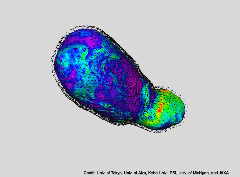Joint Research Results Conducted by The University of Aizu, the University of Tokyo, and Other Research Institutions, Appears in "Science Express"
Achievements of research regarding the asteroid "Itokawa" jointly conducted by Assistant Professor Naru Hirata, Assistant Professor Hirohide Demura from the Multimedia Systems Laboratory of The University of Aizu, researchers from the University of Tokyo, the Japan Aerospace Exploration Agency (JAXA), and other research institutions, has appeared in the April 19th issue of "Science Express", an electronic publication of selected "Science" papers (published by the American Association for the Advancement of Science), one of the most highly respected scientific publications in the world.
The research article was written by Dr. Hideaki Miyamoto, Associate Professor of the Univesity Museum, the University of Tokyo, as primary author, jointly with the project team of researchers from the University of Aizu, JAXA, Fukushima National College of Technology, Kobe University, National Institute of Advanced Industrial Science and Technology, National Astoronomical Observatory of Japan, Tokai University, and other overseas research institutions.
"Itokawa" has been probed by "Hayabusa" a spacecraft launched by JAXA. Seven articles on the first result of the research (including one written by Assistant Professor Hirohide Demura of the University of Aizu) were published in "Science" in June last year. This research included analysis of close-up images taken by "Hayabusa" and shape modeling of "Itokawa", and indicated that gravel migration has occured on the surface of "Itokawa" and that the migration caused particle segregations. It was observed that the size of the particles was dependent upon their locations. This phenomenon was the first discovery of this nature pertaining to our solar system.
Contribution of the UoA project team to the research was geographic analysis of the asteroid surface to find the direction of migration.
This figure, reproduced by computer graphics, shows the direction of the gravel migration on the asteroid surface. Each color signifies an inclination of slopes on the surface. Red is the steepest, gradually decreasing in degree as follows: yellow, green, blue, and purple. Black arrows indicate the direction the migration takes place along the slopes of the surface. Traces of the gravel migration along the direction of the arrows were discoverd by analyzing close-up images taken by "Hayabusa".

